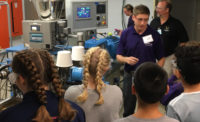Creekview Ranch Middle School marries sustainability, function

The school’s new gym. Photo courtesy New York Focus.
Creekview Ranch Middle School – a LEED-NC Gold-certified, 87,623 sq. ft. campus located in Roseville, Calif., approximately 20 miles outside Sacramento – has seen thousands of teens shuffle in and out of its doors since its opening nearly two and a half years ago. This foot traffic has helped test and validate the sustainable flooring decisions made by the Dry Creek School District and the Los Angeles-based design team of Perkins+Will.
Although representing only a small percentage of the total construction cost, the flooring plays a crucial role in reflecting the district’s new emphasis on sustainability and high performance. Following is a brief description of the key flooring products.
Carpeting
LEED credits MR 4.1 and 4.2, EQ 4.1 and 4.3
Cubic and Metamorphic carpet tile systems by Interface, with the Glasbac Tile RE backing, comprise more than 50 percent of the total flooring. Carpet tile was first specified for its performance, versatility and ease of installation and maintenance. However, the Interface tile also met high standards for recycled content (more than 50 percent in the backing) and highly sustainable manufacturing methods.
At first, the school district was hesitant to use this product. For years, the standard had been a utilitarian single-color broadloom carpet with standard installation and a “cookie cutter” cut-and-paste repair method. Knowing that carpet tile was not the district’s standard, the low-bid flooring subcontractor proposed an alternate for the standard broadloom carpet, with the lure of an apparent 15 percent cost savings.
Perkins+Will, with the help of the carpet tile manufacturer, was able to demonstrate that the
15 percent cost disappeared when the sustainable installation process was considered. Instead of the usual adhesives, 3” square adhesive stickers were applied to all four corners of the tiles.
This method virtually eliminated the VOC fumes typically associated with standard, and even low-VOC adhesives. The benefits of this system become apparent with maintenance. Any stained tiles can be quickly replaced with attic stock, using the original adhesive stickers.

One of the classrooms at the recently renovated Creekview Ranch Middle School. Photo courtesy Digital Sky.
LEED credits MR 4.1 and 4.2, EQ 4.1 and 4.3
The district’s previous standard for resilient flooring was VCT; Perkins+Will was able to demonstrate that linoleum was a better, more sustainable choice in this case. Forbo’s Marmoleum linoleum flooring with Top Shield coating was specified for heavy-traffic public areas such as lobbies and the cafeteria. Forbo’s sustainable ingredients, low-VOC installation methods and sustainable (SMART platinum) manufacturing processes became the deciding factors in its selection.
Entrance Floor Mats
LEED credits MR 4.1 and 4.2, EQ 4.1 and 5
As part of the initiative to create healthier learning environments, permanent entry floor mats were designed for all classroom entrances. Debating various factors such as exterior versus interior and permanent versus portable, the team specified Terra Turf matting by Johnsonite. The matting comes in 12” by 12” tiles for flexibility and was installed with low-VOC adhesive.
What may be the most important factor is the matting’s ingredient: 100 percent recycled tires. The students can relate to the use of everyday tires as a building material, making the matting one of the few obvious building components that can directly teach the students about the school’s sustainable design.

The new flooring is designed to withstand foot traffic from the school’s many students. Photo courtesy New York Focus.
Notable Interior Products
Flooring: Marmoleum Real Sheet Linoleum by Forbo; Cubic Modular, Transformation and Metamorphic carpet tiles by InterfaceFLOR; Johnsonite TerraTurf Recycled Tile walk-off mats; Crossville porcelain floor tile; Daltile cermaic floor tile.
Ceiling: Armstrong ACT - Fine Fissured, Optima Open Plan, Clean Room Mylar
Wood: FSC framing lumber from Lumbermens; FSC wood flooring from Action Floor Systems, Inc.
Interior Finishes and Furnishings: Skyblend Particleboard; Richlite Countertops; Trespa Toplab Plus; Icestone Countertops; American Olean quarry tile; Forbo cork board; Trespa Athlon toilet partitions.
Paints and Wallcoverings: Whispertone Wallboard by Johns Manville; Fabric wrapped acoustical paneling by Lamvin, Inc.; Tnemec, Prosoco, Valspar, Dunn Edwards and ICI paints.
NOTE: This story previously ran in a slightly different form in Environmental Design + Construction.
Looking for a reprint of this article?
From high-res PDFs to custom plaques, order your copy today!






